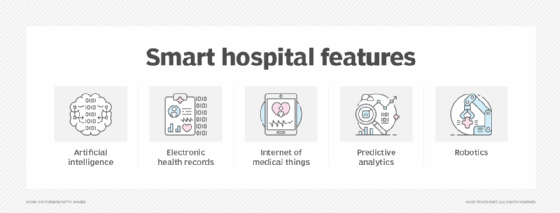What is a smart hospital?
Smart hospitals use advanced technologies such as AI, automation, internet of things (IoT) and robotics to improve efficiency and the quality of patient care.
Several factors are leading to digital transformation in the healthcare industry. The COVID-19 pandemic fueled the movement toward digitization, as remote patient care and monitoring became essential. Other factors, including the aging population, have contributed to digital healthcare, as modern tech is used to aid in disease diagnosis and clinical support.
Around the world, industry-wide digital transformation is taking place, thanks to the advent and development of technologies such as generative AI. The healthcare industry is no different, and smart hospitals are one example of modernization within the industry.
How does a smart hospital work?
A smart hospital combines multiple technologies, processes and intelligent infrastructure to improve patient experience as well as general operational management. These technologies and processes include the following:
This article is part of
AI in healthcare: A guide to improving patient care with AI
- Artificial intelligence. AI in hospitals can be used to analyze large quantities of patient data and back up clinical decision-making. By analyzing imaging data from X-rays and other scans, AI can help provide thorough diagnoses and treatment plans. In addition, AI is useful for automating repetitive and time-consuming tasks such as appointment scheduling and data entry, boosting efficiency and enabling healthcare professionals to dedicate more time to patient care.
- Electronic health records integration. Smart hospitals focus on digitizing medical records, making it easier to share patient data between healthcare professionals and facilities. EHR integration enables AI to analyze and detect abnormalities and unusual patterns in a patient's history and help with diagnosis.
- Internet of medical things. IoMT is a collection of medical devices that connect to healthcare technology systems. Examples of these devices include remote patient monitoring devices (e.g., glucose monitors), smart thermometers and smart infusion pumps.
- Predictive analytics. Predictive analytics improve the overall efficiency of hospital management. The capability can be used to understand resource allocation, run risk assessments and even reduce costs by preempting medical emergencies and hospital readmissions.
- Robotics. Robotics can assist in several tasks, including surgery, sanitation and disinfection, patient transport and patient care such as rehabilitation and companionship.
Benefits of a smart hospital
Smart hospitals offer several benefits for both patients and medical professionals. These benefits include the following:
- More patient safety. With enhanced data integration and smart technologies in place, patient safety becomes easier to achieve. Doctors can track patients within the hospital and respond to emergencies quickly.
- Greater operational efficiency. When using technologies such as AI and robotics to assist with day-to-day hospital management, workflows such as scheduling and billing can be streamlined and automated. This benefits hospital workers by freeing up workloads and reducing time spent on time-consuming tasks.
- Improved patient care. Real-time remote monitoring with devices such as smart watches and glucose monitors enables doctors to detect problems early and treat them as soon as possible. Other technologies, such as AI, predictive analytics and robotics, work together by analyzing patient data and providing personalized care plans.
- Personalized treatment for patients. Advancements in technology and the integration of patient data enable doctors and medical professionals to tailor treatment plans to the patient.
- Reduced costs. Smart hospitals can reduce the number of readmissions, lowering costs by reducing resources wasted. They are also energy efficient. With utility costs reduced, smart hospitals can save money and direct it toward patient care and innovation.
- Telehealth. Telehealth, or telemedicine, is the remote delivery of healthcare services over a telecommunications infrastructure. Convenient for both doctors and patients, it enables medical professionals to treat patients remotely and patients to communicate with doctors from their own homes.
The advancements and technological development of smart hospitals improve patient-centric care, making patient well-being a priority. Meanwhile, doctors have greater assistance with everything from operations to medication dispensing, making it easier for them to do their jobs to the best of their ability.

Smart hospitals vs. traditional hospitals
The core difference between a traditional hospital and a smart hospital is the adoption of technology to enhance efficiency and patient care. Below are some examples of workflows and how they are managed in a traditional hospital versus a smart hospital.
1. Data collection and analysis
Traditional hospital: Paper records, manual data collection and staff observations are the main data collection methodologies in traditional hospitals. These methods are often time-consuming and can lead to a greater instance of human error.
Smart hospital: Real-time, automated data collection from remote wearable technologies is collected and integrated into hospital systems, allowing for continuous AI analysis.
2. Use of automation
Traditional hospital: Clerical work is intensive. Data collection, appointment scheduling and billing are manual processes.
Smart hospital: Reporting done by AI and through software achieves a much higher level of automation. With less clerical work, doctors can prioritize patient well-being over administrative work.
3. Innovation and digital transformation
Traditional hospital: Traditional hospitals rely on outdated systems, and healthcare often falls behind other industries when it comes to embracing digital transformation. Outdated IT systems, fax machines and phones/pagers for communication are all still part of a traditional hospital's tech portfolio. Outdated technology can slow workflows down and compromise patient care.
Smart hospital: Smart hospitals are much more likely to embrace new technology, including augmented reality, virtual reality and 3D printing. AR and VR have been used for training, diagnostics and even pain management, while 3D printing can create anatomical guides for preoperative planning.
How hospitals can begin transitioning to smart hospitals
Any hospital can become a smart hospital. The process involves assessing hospital needs and investing in technology and innovation by upgrading infrastructure, training employees and advancing digital transformation. Below is a five-step plan to become a smart hospital.
1. Assess current workflows
The first step toward becoming a smart hospital involves looking inward and understanding what is already working well and where there are gaps. For example, if a hospital already uses EHRs, is data optimization in place? Are workflows simplified? How is this data used, and is there an opportunity to begin integrating AI tools and software?
2. Speak to staff and patients
By speaking to members of staff as well as patients, hospitals can identify areas of improvement and assess whether these areas can be optimized by embracing new technology.
3. Define clear, achievable goals
Once areas of weakness have been identified, laying out a clear vision for the future is essential to help keep on track with change. These goals should be communicated to hospital leadership, and a roadmap should be put in place across the entire hospital, including HR, finance and accounting. This ensures the entire hospital ecosystem works toward the same goal.
4. Start small
When looking for technology to bring into the hospital ecosystem, start with tools that will act as the foundation for future innovation. For example, optimized EHR systems are the building blocks of data management, and optimizing early will help keep the hospital on track. Other examples of technologies to start with include the following:
- Data storage. It is important to store clinical data securely for future analysis and to act as the foundation for a predictive analytics platform.
- Medical device integration. Medical device integration involves linking all medical devices into a central system to enable real-time monitoring. Having this system in place early on will enable hospitals to maximize the use of devices such as smart beds, location sensors and wearable devices.
- Network infrastructure. Ensure that the connection across the hospital is robust and secure. Future devices will rely on Wi-Fi and strong connectivity.
5. Embrace cybersecurity
As with any form of digitization, there will be a risk of data leaks and ransomware. Keeping patient data safe and secure should be a top priority for smart hospitals. Applying multilayered security across all devices, training hospital staff and regularly auditing and testing for vulnerabilities are all essential.








